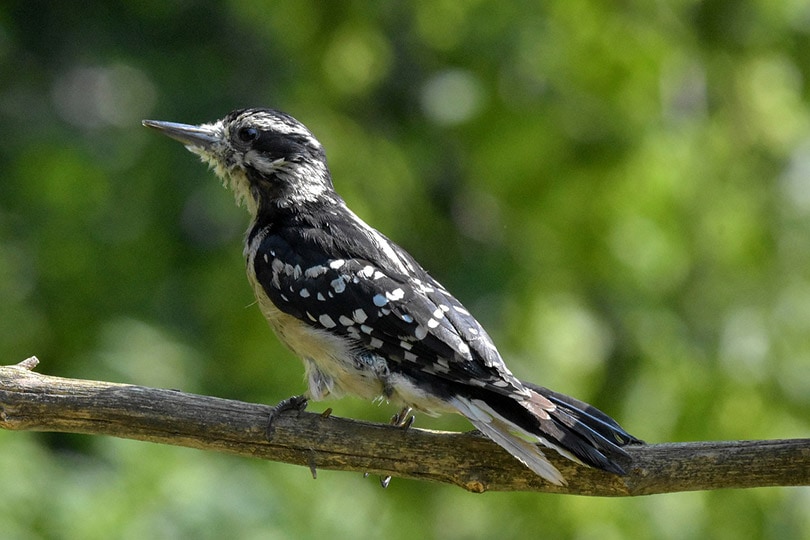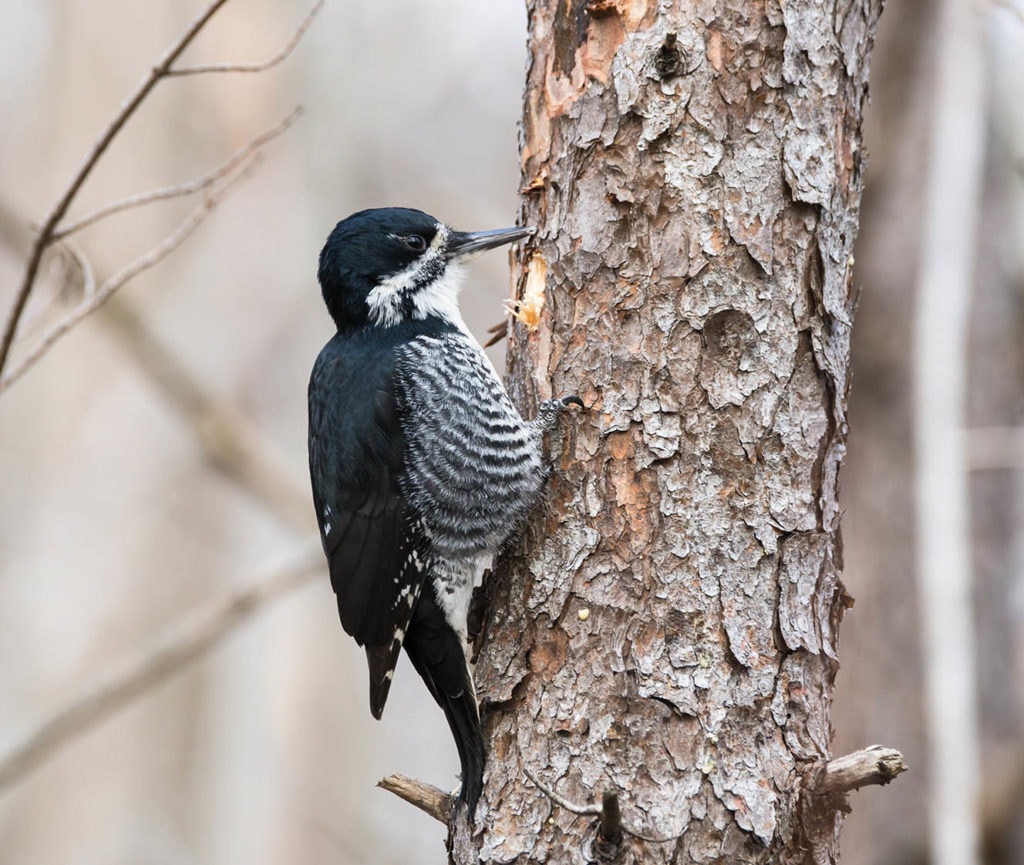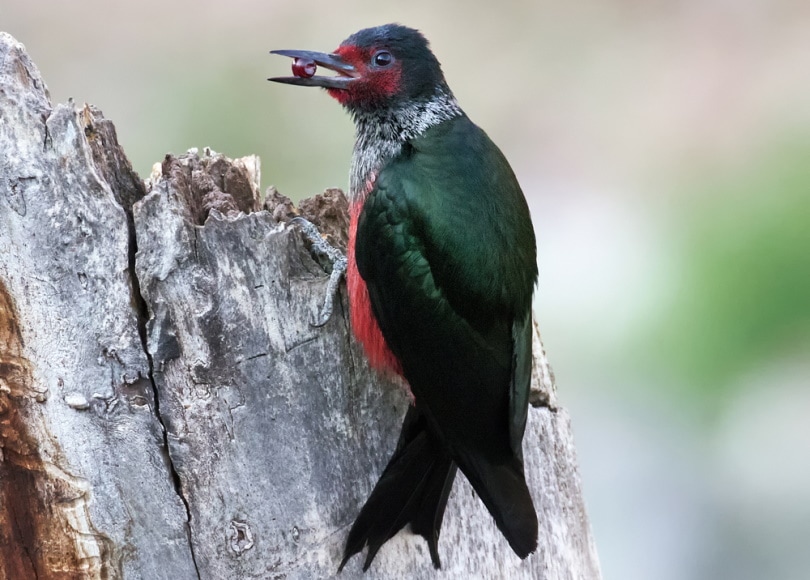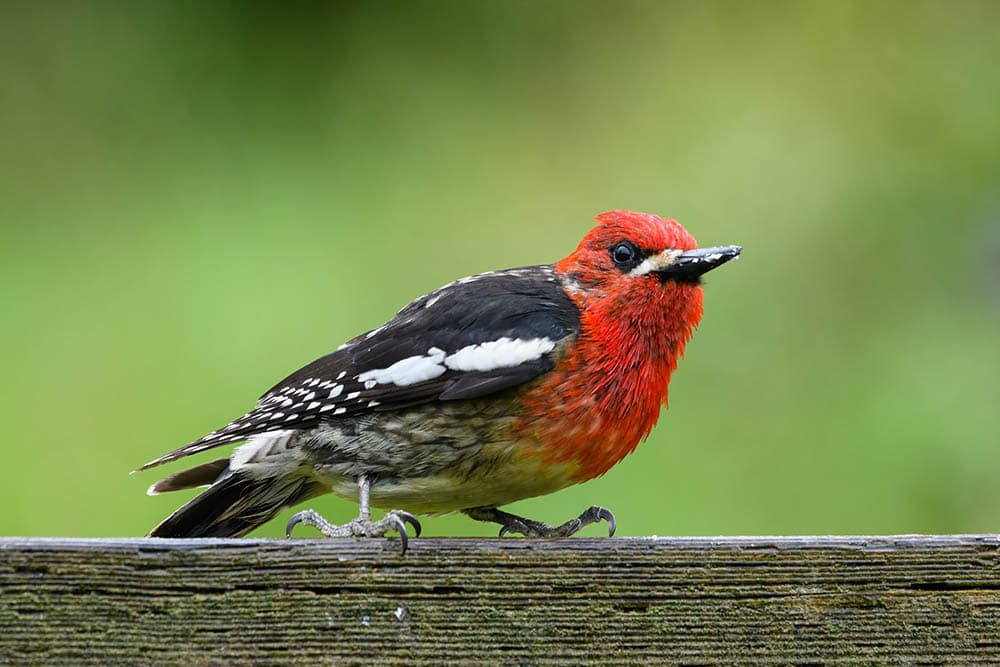12 Species of Woodpeckers In Oregon (with Pictures)
Last Updated on

Woodpeckers are some of the most interesting birds to find in the wild. They cling to the sides of trees and hammer into the trunks with their powerful beaks. Most people think of Woody Woodpecker when they imagine these birds, but they are actually quite diverse. There are a dozen species of woodpecker in Oregon alone that range from tiny black and white creatures to large crow-like animals. Many woodpeckers have unique cries that make them a popular type of Oregon songbird.
These are the twelve species of woodpecker officially known to be native to the state of Oregon.

The 12 Species of Woodpeckers in Oregon
1. Pileated Woodpecker

| Scientific name | Dryocopus pileatus |
| Status | Least Concern |
The pileated woodpecker is the most recognizable species of woodpecker in North America. It is distinguishable by its large red plume and large black body. The distinctive red color on the head makes it one of the most recognizable red birds in Oregon. The pileated woodpecker is also the largest species of woodpecker in North America and one of the largest species in the world. Itfeasts on bugs from deadwood and softwood using its powerful beak. The chattering of the pileated woodpecker as it plies away in the woods is a common sound familiar to many.
The pileated woodpecker can be found from Florida to Oregon and makes its home in both old and new forests. Ithas adapted well to survive alongside humans. They make their nests in downed trees and large tree hollows. When it comes to iconic birds, the pileated woodpecker is near the top of the list in terms of recognition.
2. Black-backed Woodpecker

| Scientific name | Picoides arcticus |
| Status | Least Concern |
The black-backed woodpecker is known for its inky black appearance. The entire back of this bird is a deep black color. It also sports a gray or white belly. Black-backed woodpeckers are most often found in forests that have recently burned in wildfires. The black-backed woodpecker forages in newly burned trees and dead trees for its prey.
Areas of Oregon that experience annual forest fires make the perfect habitat for this medium-sized bird. If you go hiking in areas that burned in the previous season, there is a good chance you can see and hear the black-backed woodpecker happily pounding away at the charred trunks of old trees.
3. Northern Flicker

| Scientific name | Colaptes auratus |
| Status | Least Concern |
The northern flicker has an unusual appearance for a woodpecker. It has a gray body with black spots throughout. The head has a blue-colored thrush with a red flare. Unlike other species of woodpecker, the northern flicker likes to live near trees that border open areas. They do not like to inhabit dense or old-growth forests. Instead, they can be found in loosely packed forests located near fields, meadows, and other open areas. The northern flicker also spends more time on the ground than other woodpeckers.
Northern flickers are a common sight throughout much of Oregon. They routinely venture into rural communities and small towns that are surrounded by open forests.
4. White-headed Woodpecker

| Scientific name | Picoides albolarvatus |
| Status | Least Concern |
The white-headed woodpecker ranges in the Pacific Northwest from California through Washington. They are most often found in old pine forests and like to make their homes among sugar pine and ponderosa pine trees. The white-headed woodpecker is a small species most easily recognized by its white head and diminutive body.
Unlike other woodpeckers, the white-headed woodpecker eats both bugs and seeds. The seeds from ponderosa pine trees make up a large portion of this bird’s diet. Other woodpeckers eat bugs primarily, but this species has adapted to eat both bugs and seeds, making it unique.
5. American Three-toed Woodpecker

| Scientific name | Picoides dorsalis |
| Status | Least Concern |
The American three-toed woodpecker is rare to spot in Oregon. It primarily makes its home in high elevation forests that have high concentrations of bark beetles. The American three-toed woodpecker follows the outbreaks of these wood-boring insects since the beetles are its primary source of food. The American three-toed woodpecker is largely found in more northern latitudes where the presence of these bark beetles is more common. States such as Alaska suffer from massive outbreaks of bark beetles and have denser populations of three-toed woodpeckers as a result. The American three-toed woodpecker is one of the only brown woodpecker birds in Oregon.
In Oregon, the American three-toed woodpecker is primarily found at high elevations west of the Cascade mountains. They like to make their nests near water, such as high elevation lakes or streams. The presence of wood bark beetles is the best indication that three-toed woodpeckers might be nearby.
6. Lewis’s Woodpecker

| Scientific name | Melanerpes lewis |
| Status | Least Concern |
Unlike most species of woodpecker, Lewis’s woodpecker primarily feeds by snatching bugs out of midair. Birds that behave this way are often called flycatchers. Lewis’s woodpecker hunts more like a flycatcher than it does a woodpecker. They will sit at the top of dead or burned trees for long hours and swoop down to grab bugs out of the air as they fly by.
Lewis’s woodpecker can be found throughout the western United States and often inhabit open pine forests and forests that recently experienced a wildfire. The woodpecker was named after Meriweather Lewis, one of the chief explorers of the Lewis and Clark expeditions. Many bird watchers describe Lewis’s woodpecker as looking like and behaving like a crow more than a typical woodpecker.
7. Acorn Woodpecker

| Scientific name | Melanerpes formicivorus |
| Status | Least Concern |
Acorn woodpeckers get their name from their behavior. Acorn woodpeckers hoard acorns like squirrels. They spend the warm seasons traveling in large groups that bore holes into the side of trees and stash the acorns for later. These birds can be found as far north as northern Oregon and as far south as southern Mexico. Due to their propensity to gather in large groups, these birds are easy to spot. They primarily like to live in oak forests where their beloved acorns can be found in abundance.
Acorn woodpeckers also have a distinct face that many people describe as being clown-like. Acorn woodpeckers also have a distinct call that sounds almost like a flock of parrots. The distinct call of the acorn woodpecker makes it a unique Oregon songbird. These distinctive features make these birds easy to spot and identify.
8. Williamson’s Sapsucker

| Scientific name | Sphyrapicus thyroideus |
| Status | Low Concern |
Williamson’s sapsucker is not a permanent resident in many parts of Oregon. Instead, the birds come to Oregon during the breeding season to nest and lay their eggs. Williamson’s sapsucker makes its permanent home in areas farther south and west than Oregon. The most interesting thing about this bird species is the fact that the males and females look completely different.
The two sexes look so different that for the longest time, scientists and bird watchers alike believed that they were two separate species. It wasn’t until 1873 that specialist ornithologists realized that these two distinct-looking birds were from the same species. Learning to distinguish the males from the females and recognize them as Williamson’s sapsuckers is an impressive feat that amateur bird watchers strive for.
9. Red-naped Sapsucker

| Scientific name | Sphyrapicus nuchalis |
| Status | Least Concern |
Red-naped sapsuckers are beautiful woodpeckers with a lot of color and personality. These birds appear in Oregon during the warm summer months, where they love to feast on the sap of mature trees. Red-naped sapsuckers drill lines of neat holes in trees with sweet sap. They are permanent residents in areas farther south, but they migrate north to breed and eat during the summer.
The red-naped sapsucker is distinguished from other sapsuckers by its red crest. They appear in forests where sap wells are common, and they can be picked out by their colorful plumage and aggressive cries. Many bird watchers describe the red-naped sapsucker as raspberry, and their appearance is one of the best examples of red birds in Oregon.
10. Red-breasted Sapsucker

| Scientific name | Sphyrapicus ruber |
| Status | Least Concern |
The red-breasted sapsucker is distinguished by an extremely bright colored plume and breast. The shock of red makes these birds easy to spot. Red-breasted sapsuckers are the only species of sapsucker that can be routinely found in western Oregon. Other species of sapsucker are migratory in the area and spend more of their time in the south than they do in the northwest.
Red-breasted sapsuckers have a unique tongue that is shaped like a brush to lap up sap more effectively. Their sharp beaks create sap wells in trees where the sap slowly oozes out of the holes created by the birds. These oozing sap holes service many other animals in the environment that enjoy the sap alongside the red-breasted sapsucker.
11. Downy Woodpecker

| Scientific name | Picoides pubescens |
| Status | Least Concern |
Downy woodpeckers are one of the smallest and most common woodpeckers in North America. Their habitat stretches from south Florida to Alaska. These birds are extremely small and are much smaller than most other woodpecker species. The downy woodpecker is often missed because it blends in with other tiny birds like chickadees. Like chickadees, downy woodpeckers are extremely well adapted to dense human areas. These birds are often seen at parks, backyard bird feeders, and public forests.
These woodpeckers have small fluffy black and white bodies with a small patch of red on the top of their head. The best place to spot them is among flocks of other tiny birds like chickadees. They can be found all over Oregon.
12. Hairy Woodpecker

| Scientific name | Picoides villosus |
| Status | Least Concern |
The hairy woodpecker is one of the most widely distributed woodpeckers in North America. Hairy woodpeckers can be found in almost any forest in the United States, including Oregon. Hairy woodpeckers are so widespread because they are not picky eaters. Hairy woodpeckers eat everything from beetles to ants to spiders as well as seeds, corn, and nuts. This diverse diet makes the hairy woodpecker adaptable to a variety of different climates.
These birds can be found all over Oregon. If there is a forest of any size or shape, there is a good chance that it contains families of hairy woodpeckers. In Oregon, the hairy woodpecker follows forest fires and beetle infestations in order to find its favorite types of food.

Tips For Spotting Woodpeckers In Oregon
Knowing where to look is the best way to find woodpeckers in Oregon. Some woodpeckers only appear during certain seasons, some woodpeckers only live in high elevations, and some woodpeckers only stick to certain species of trees. Knowing what environment the woodpeckers live in is the best way to pinpoint a place to look for them. Common woodpeckers like the hairy woodpecker and pileated woodpecker can be spotted almost anywhere that there are trees, while other species will need more careful planning to track down.
Once you have a spot picked out, the best thing to do is keep your eyes trained on the trees. Woodpeckers like tops of trees, dead trees, burned trees, and large branches. Staying quiet and calm will make it more likely to spot one of these birds in the wild.

Keep Your Ears Open
Woodpeckers can be located using sound more often than just your eyes. Some woodpeckers have distinct calls that can fill a forest when they are nearby. The acorn woodpecker, for example, has a very loud and distinct call. Woodpeckers also make a hammering noise while they are pecking. This rhythmic sound can be heard from long distances and can help point you in the right direction of an active woodpecker habitat.
Sapsucker vs. Woodpecker
There are a handful of sapsuckers on this list that might have you wondering, what the heck is a sapsucker? Sapsuckers are a special species of woodpeckers that use their beaks to drill into trees in order to access their sap rather than insects. The sap from certain trees is very sweet and contains a lot of sugar and energy for the birds. Sapsuckers still bore into trees, but instead of looking for ants and beetles, they are trying to get into sap wells so they can suck up the sticky nectar.

In Conclusion
Each of these woodpeckers is special in its own way. Each species of woodpecker has its own pattern of behavior and unique cries that make them fascinating to look for and watch. Oregon woodpeckers are great songbirds and fantastic hunters. Once you know where and when to look, these birds are not hard to spot. It will brighten your day next time you see one of these animals in the wild.
Featurd Image Credit: JackBulmer, Pixabay
About the Author Robert Sparks
Robert’s obsession with all things optical started early in life, when his optician father would bring home prototypes for Robert to play with. Nowadays, Robert is dedicated to helping others find the right optics for their needs. His hobbies include astronomy, astrophysics, and model building. Originally from Newark, NJ, he resides in Santa Fe, New Mexico, where the nighttime skies are filled with glittering stars.
Related Articles:
Monocular vs Telescope: Differences Explained (With Pictures)
10 Types of Hummingbirds in Arkansas (With Pictures)
8 Types of Hummingbirds in Nebraska (With Pictures)
5 Types of Hummingbirds in Idaho (With Pictures)
3 Types of Hummingbirds in Mississippi (With Pictures)
8 Types of Hummingbirds in Kansas (With Pictures)
5 Types of Hummingbirds in West Virginia (With Pictures)
5 Types of Hummingbirds in Ohio (With Pictures)
